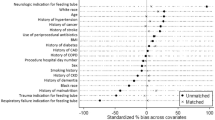Abstract
OBJECTIVE: Percutaneous endoscopic gastrostomy (PEG) tube placement is the preferred method for long-term enteral feeding of patients who are unable to take food by mouth. Despite the widespread acceptance of the procedure, no large-scale study of the long-term outcomes of patients receiving PEG tubes has been reported. The objective of this study was to determine the survival of patients in whom PEG tubes are placed.
DESIGN: Retrospective cohort study using data obtained from two computerized databases.
SETTING: Department of Veterans Affairs hospitals.
PATIENTS: Seven thousand three hundred sixty-nine patients who received a PEG tube in fiscal years 1990 through 1992.
RESULTS: For the 7,369 patients, the mean age was 68.1 years and 98.6% were men. PEG tubes were most commonly placed in patients with cerebrovascular disease (18.9%), other organic neurologic disease (28.6%), or head and neck cancer (15.7%). Although the complication rate of the procedure itself was low (4%), because of the severity of their underlying disease, 1,732 patients (23.5%) died during the hospitalization in which the PEG tube was placed. The median survival of the full cohort was 7.5 months.
CONCLUSIONS: This study documents the widespread placement of PEG tubes in severely ill patients, half of whom are in the terminal phase of their illness. Further study is needed to determine whether these patients benefit from PEG tube placement in terms of their quality of life and survival.
Similar content being viewed by others
References
Gauderer MWL, Ponsky JL, Izant RJ. Gastrostomy without laparotomy: a percutaneous endoscopic technique. J Pediatr Surg. 1980;15:872–5.
Ponsky JL, Gauderer MWL. Percutaneous endoscopic gastrostomy: a nonoperative technique for feeding gastrostomy. Gastrointest Endosc. 1981;27:9–11.
AGA Health Care Reform Update. American Gastroenterological Association. 1993;1–5.
Larson DE, Burton DD, Schroeder KW, DiMagno EP. Percutaneous endoscopic gastrostomy. Indications, success, complications, and mortality in 314 consecutive patients. Gastroenterology. 1987;93:48–52.
Miller RE, Castlemain B, Lacqua FJ, Kotler DP. Percutaneous endoscopic gastrostomy. Results in 316 patients and review of literature. Surg Endosc. 1989;3:186–190.
Horton WL. Colwell DL, Burlon DT. Experience with percutaneous endoscopic gastrostomy in a community hospital. Am J Gastroenterol. 1991;86:168–70.
Gibson SE, Wenig BL, Watkins JL. Complications of percutaneous endoscopic gastrostomy in head and neck cancer patients. Ann Otol Rhinol Laryngol. 1992;101:46–50.
Grant JP. Percutaneous endoscopic gastrostomy. Initial placement by single endoscopic technique and long-term follow-up. Ann Surg. 1993;217:168–74.
Fuchs VR, Garber AM. The new technology assessment. N Engl J Med. 1990;323:673–7.
Division of Quality Control Management, American Hospital Association. International Classification of Diseases, Ninth Revision, Clinical Modification. Chicago, Ill: American Hospital Publishing Inc; 1989.
Fleming C, Fisher ES, Chang CH, Bubolz TA, Malenka DJ. Studying outcomes and hospital utilization in the elderly. The advantages of a merged data base for Medicare and Veterans Affairs hospitals. Med Care. 1992;30:377–91.
Kaplan EL, Meier P. Nonparametric estimation from incomplete observations. J Am Statist Assoc. 1958;53:457–81.
Jain NK, Larson DE, Schroeder KW, et al. Antibiotic prophylaxisfor percutaneous endoscopic gastrostomy. A prospective, randomized, double-blind clinical trial. Ann Intern Med. 1987;107:824–8.
Park RHR, Allison MC, Lang J, et al. Randomized comparison of percutaneous endoscopic gastrostomy and nasogastric tube feeding in patients with persisting neurological dysphagia. BMJ. 1992;304:1406–9.
Rabeneck L. Why should gastroenterologists know about outcomes research? Gastrointest Endosc. 1993;39:723–5.
Wolfsen HC, Kozarek RA, Ball TJ, Patterson DJ, Botoman VA, Ryan JA. Long-term survival in patients undergoing percutaneous endoscopic gastrostomy and jejunostomy. Am J Gastroenterol. 1990;85:1120–2.
Fay DE, Poplausky M, Gruber M, Lance P. Long-term enteral feeding: a retrospective comparison of delivery via percutaneous endoscopic gastrostomy and nasoenteric tubes. Am J Gastroenterol. 1991;86:1604–9.
Taylor CA, Larson DE, Ballard DJ, et al. Predictors of outcome after percutaneous endoscopic gastrostomy: a community-based study. Mayo Clin Proc. 1992;67:1042–9.
Brook RH, Park RE, Chassin MR, Solomon DH, Keesey J, Kosecoff J. Predicting the appropriate use of carotid endarterectomy, upper gastrointestinal endoscopy, and coronary angiography. N Engl J Med. 1990;323:1173–7.
Chassin MR, Kosecoff J, Park RE, et al. Does inappropriate use explain geographic variations in the use of health care services? A study of three procedures. JAMA. 1987;258:2533–7.
Author information
Authors and Affiliations
Additional information
From the Department of Veterans Affairs Health Services Research and Development (HSR&D) Field Program, and the Department of Medicine, Baylor College of Medicine, Houston, Tex.
Supported by the Department of Veterans Affairs Health Services Research and Development Houston Field Program.
Rights and permissions
About this article
Cite this article
Rabeneck, L., Wray, N.P. & Petersen, N.J. Long-term outcomes of patients receiving percutaneous endoscopic gastrostomy tubes. J Gen Intern Med 11, 287–293 (1996). https://doi.org/10.1007/BF02598270
Issue Date:
DOI: https://doi.org/10.1007/BF02598270




